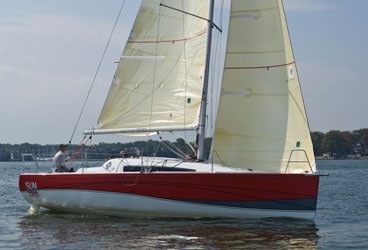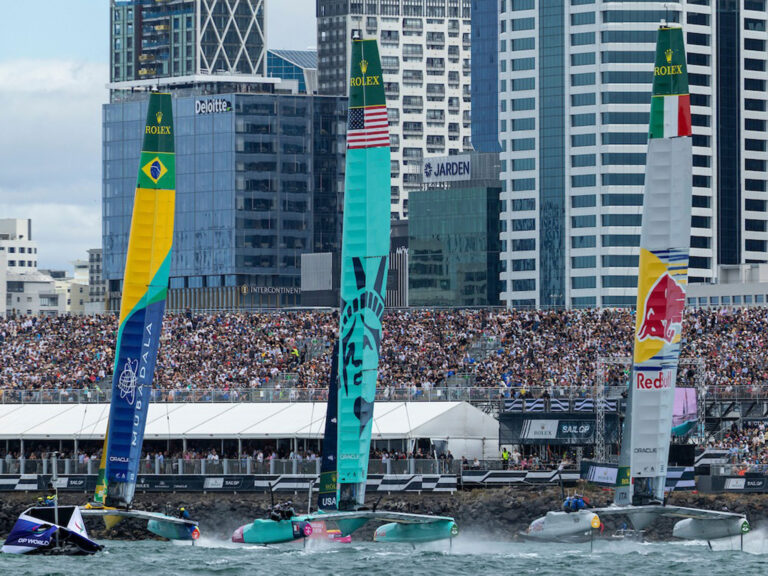
368 Jeanneau Sun Fast 3200
The shorthanded sailing scene in Europe is on fire these days, fueled by the many solo and doublehanded races that grab the headlines. Jeanneau, the 50-year-old boatbuilder, is based in Les Herbiers, France, so it’s not surprising they’re in on the action with the Sun Fast 3200. From all accounts thus far, those who regularly go it alone, or with a mate or two, will be impressed with this versatile 33-footer.
The goal with the 3200, says its designer, Daniel Andrieu, was straightforward: a boat that is fast, simple, and safe for amateur shorthanded offshore sailors. Stiffness, as well as initial and ultimate stability, says Andrieu, topped Jeanneau’s priority list. Consequently, the boat falls on the wide side and is built as light as possible, which has allowed them to stuff nearly 3,000 pounds of its 7,496-pound light displacement into the iron fin and lead keel bulb. They get their weight savings by using resin infusion and balsa coring, and with lightweight interior components throughout, i.e., soft storage compartments and panels en lieu of cabinets and doors. Composite accents used wherever possible contribute to the boat’s weight-savings program and give it just enough high-tech flash inside to make it feel state-of-the-art.
Shorthanded crews don’t have the benefit of rail meat, so, as Andrieu points out, the boat had to be stiff enough to allow the full working sail plan-a 370-square-foot main and 340-square-foot overlapping headsail-to be carried well into the wind range. This boat certainly has sufficient beam from amidships aft, which doesn’t help its light-air performance. But such a shape is desirable for shorthanders, says Rich du Moulin, commodore of the Storm Trysail Club (N.Y.), who extensively campaigns his Express 37 offshore in shorthanded fashion. “You want initial stability-more than average is better,” he says, “because without any crew on the rail, any boat will need to change down jibs or reef much sooner.”
Such a shape also encourages dual rudders, which adds a lot of undesirable wetted surface. But one important trade-off for the shorthander to consider, says SW Boat of the Year Judge Barrett Holby, who has thousands of shorthanded miles, is that twin rudders allow any autopilot to work well with a generous amount of sail. The autopilot gets a lot of helm time on shorthanded races, and an autopilot tied into a neutral helm lessens the drain on the batteries dramatically.
SW’s BOTY Judges (Holby, Greg Stewart, and Chuck Allen) test sailed the boat in Annapolis in October. Given the light winds they were dealt, says Holby, the boat felt “sticky.” However, he adds, given more wind their ultimate impression would’ve been very different.
Andrieu admits that the boat does suffer in the light stuff, but it comes alive as the speedo climbs. “In zero to six knots it’s very difficult, but after that, it’s very fast. You can easily carry the main and full genny up to 25 knots.”
Andrieu’s claim was confirmed by Tim Kent, a veteran of the Around Alone race, who took the boat for a spin with a full crew for one breezy distance race on the Chesapeake last fall.
“We started going upwind and most of us piled on to the rail. In the gusty breeze, the boat kept on its feet,” wrote Kent (his full review is at sailingworld.com/0903kent). “The twin rudders kept working at an angle of heel that would have left a single rudder wagging in the air. As soon as we headed downwind, the boat really made tracks. With winds beginning to gust into the 30s, it handled the spinnaker well. Downwind, the volume forward kept the bow up in gusts that caused trouble for bigger boats in our fleet and made surfs linger just a little bit longer.”
When they first set the spinnaker, a 893-square-footer flown off an aluminum pole, they were comfortably flying with speeds in the low double digits. “Our top speed with the spinnaker up was 14.8 knots, and the boat was unflustered,” said Kent.
Detailed for shorthanding
To better understand what would make a simple production boat a good shorthanded racer, we turned to du Moulin for insight. Not surprisingly, his list came back long and detailed. Many of his requirements focus on the business end of the boat-the cockpit. Here, he says, you want protection, and you want all halyards, sheets, and cockpit winches within easy reach from the helm. You want a tiller (or in this case, tillers) long enough to allow you sit at the forward end of the cockpit. The 3200’s cockpit, Holby and Du Moulin agree, has it all right. The mainsheet and backstay control are easy to reach, led to floor-mounted cleats (there’s a fine and gross tune); the headsail winch is right at the helmsman’s side. Cabin-top winches handle all the respective sail controls, which are led to clutch banks on either side of the deep companionway. The pit itself is expansive. All-in-all, says Holby, it’s a pretty simple layout with room enough for a crew to stay out of each other’s way.
The European sailing media named the 3200 its 2008 European Boat of Year, hailing its “innovative approach to simplicity.” Simplicity, after all, is a shorthanded sailor’s best practice. Simple, too, is the swept-spreader aluminum rig and symmetric spinnaker setup. The natural question, however, given the proliferation of sprit-flown asymmetrics nowadays, might be, “Why the symmetric spinnaker?” To this point, Andrieu reminds us of the boat’s intended purpose, IRC considerations aside.
“When sailing offshore you are always wanting to go down, down, down,” he says. “If you can only reach then you lose the possibility to go downwind.”
But there’s a benefit to the symmetric setup, says Du Moulin, who himself prefers sprit-flown asymmetric sails for reaching. Doublehanders tend to do a lot of wing-on-wing when the wind gets to 25 knots, and under IRC you can use a pole to wing a jib, even if you are rated for an asymmetric. “Medium air is where the symmetric will dominate the asymmetric,” he says, “especially on a displacement hull.” To facilitate fast reaching, however, there’s a short, stainless steel sprit/bobstay from which a roller-furling reacher can be flown. In other words, you can get downwind any way you’d like.
The 3200’s simplicity carries into the interior, too. The fabric storage compartments are not only lighter and less expensive than cabinetwork, but also give the boat a much more open feel. There’s plenty of storage under the berths, which come standard with lee cloths, and the two double aft cabins present plenty of room for gear storage while racing or grabbing 40 winks when not. There’s a nav station to port, and a galley to starboard with a fridge and two-burner stove. In the bow section there’s a head, sink, and holding tank. There’s a watertight hatch in the forward bulkhead, a safety feature that still lets you get to belowdeck fasteners.
“The boat has a lot of great ideas,” says Holby. “I really like the details and workmanship of the interior, which is simple, yet had all the amenities you need on a boat for weekend cruising. The 3200 really is my type of boat.”
Apparently it’s Andrieu’s ideal boat as well. In 30 years of designing production boats, he says, the 3200 is the first of his own designs he’s ever bought to race and cruise with his wife and family. With one-design class rules already in place as well, he and the growing number of 3200 owners may be sailing around shorthanded, but they’ll rarely be alone.
Jeanneau Sun Fast 3200
LOA 33’1″
LWL 32′
Beam 11’5″
DISP 7,496 lbs.
SA (u/d) 654/1,237 sq. ft.
Price (base) $154,900
Website www.jeanneau.com





